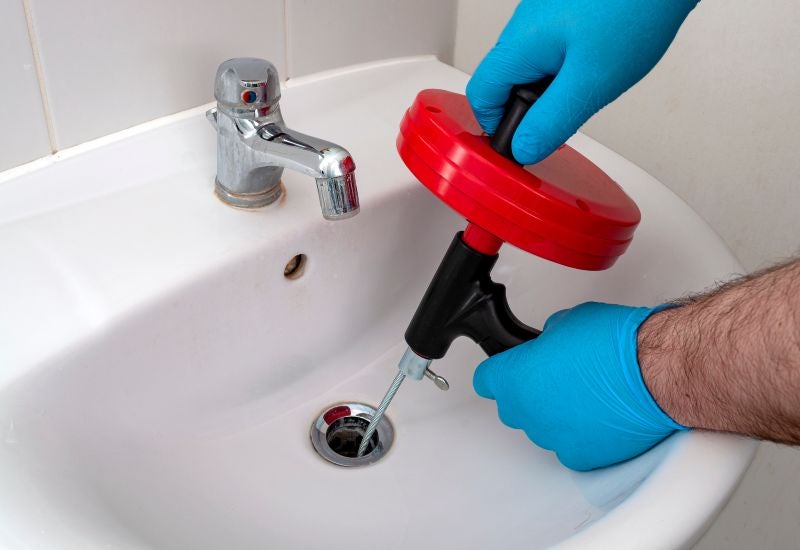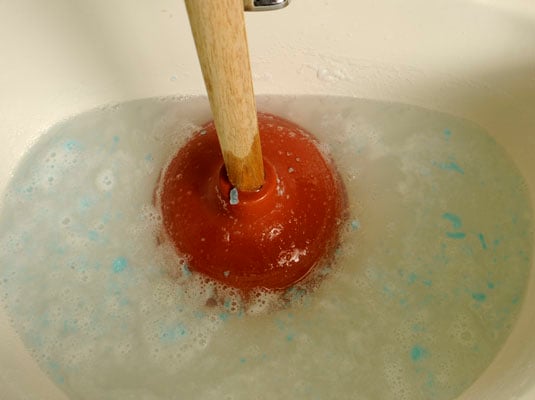Applying Plunger and Drain Cleaner: Successful Strategies
Applying Plunger and Drain Cleaner: Successful Strategies
Blog Article
We have come across this post involving How to Use a Plunger to Unclog a Toilet or Drain directly below on the net and accepted it made sense to relate it with you on my blog.

Introduction
Correct upkeep of family drains is important for preventing clogs and making certain smooth water circulation. One of the trick tools in every home owner's toolkit is the bettor, together with various drainpipe cleaners developed to deal with persistent clogs successfully. This short article discovers how to utilize bettors and drain cleansers effectively to keep your drains pipes moving freely.
Section 1: Understanding Bettors
Sorts of Plungers
There are several types of plungers available, each created for various kinds of drains and blocks. One of the most usual types include cup plungers, flange bettors, and accordion plungers.
How Plungers Work
Plungers deal with the principle of producing pressure and suction to displace obstructions. When properly applied over a drain, they create a vacuum cleaner that can pull out particles or break up blockages.
Picking the Right Plunger
Selecting the right bettor depends upon the kind of drainpipe and the nature of the blockage. Mug plungers are suitable for sinks and tubs, while flange bettors are better fit for toilets because of their design.
Typical Blunders with Plungers
Preventing these mistakes makes certain effective plunging: inappropriate seal around the drain, inadequate force, and not clearing surrounding particles.
Area 2: Utilizing Plungers Properly
Prep work
Before plunging, ensure the plunger covers the drainpipe entirely and creates a limited seal. Clear any kind of visible particles around the drain opening.
Method
Start with mild plunging activities to build suction. Boost pressure progressively, utilizing a consistent rhythm. Repeat as needed up until the drain removes.
Troubleshooting Tips
If plunging doesn't work, try adjusting the seal, applying oil jelly for a far better seal, or making use of a various kind of bettor.
Section 3: Understanding Drainpipe Cleaning Company
Kinds Of Drainpipe Cleansers
Drain cleansers can be chemical or enzymatic. Chemical cleansers make use of strong chemicals to liquify blockages, while enzymatic cleansers use all-natural enzymes to break down organic matter.
Just How Drainpipe Cleansers Work
Chemical cleaners respond with clogs to liquify them, while enzymatic cleansers break down natural materials like hair and oil without damaging pipelines.
Safety Factors to consider
Constantly put on gloves and eye protection when using chemical drain cleaners. Make sure ample ventilation and comply with maker directions thoroughly.
Eco-Friendly Alternatives
Take into consideration making use of vinegar and baking soda or enzyme-based cleansers for eco-friendly choices that are more secure for pipes and the environment.
Section 4: Using Drain Cleaners Successfully
Application Methods
Pour chemical cleansers straight right into the drain opening. Permit them to help the suggested time prior to flushing with warm water. Enzymatic cleansers ought to rest over night.
Preventative measures
Stay clear of mixing various types of cleansers, as this can produce harmful fumes. Never ever utilize chemical cleansers along with a bettor, as spilling can take place.
Managing Stubborn Clogs
For consistent obstructions, think about making use of a pipes serpent or calling a professional plumbing professional to stop damages to pipelines.
Conclusion
Finally, recognizing how to use bettors and drain cleansers effectively is vital for maintaining healthy and balanced pipes systems. By picking the right tools and strategies, homeowners can tackle minor obstructions and protect against significant plumbing concerns down the line.
How To Properly Use A Plumbing Snake To Clear Drains
When any drain clogs in our home arise, we tend to gravitate toward the plunger and little else. In cases where the plunger and its vacuum-created pressure are not able to clear clogs, many immediately move to harmful chemicals or simply call their plumber to fix the issue.
we’re happy to help with all drain cleaning needs and concerns. This includes informing you on a few other home remedies you may have at your disposal for minor to moderate clogs, one of which is the use of a plumbing snake. Many people have never used one of these before – let’s go over the steps to take when your drain clogs and you have a plumbing snake available.
Attempt Plunger Use
The first step here, as we noted above, should indeed be to grab your plunger when you notice a drain clog and attempt to resolve it this way. If you’re unsure how to use a particular type of plunger, our plumbers can answer any questions you have. If this doesn’t do the trick, however, you move on to the snake.
Locate And Prepare Snake
A plumbing snake is a metal or plastic device that’s generally about a quarter of an inch thick. It’s design with significant extensions, meant to reach down into your clogged drain and push the clog out. Snakes also contain drain augers that will latch onto and push stubborn blockages.
If your plunger doesn’t clear a clog, locate your snake and bring it to the drain in question. We also recommend keeping a bucket nearby to collect the clog once you pull it out, plus we’d advise wearing goggles and possibly protective gloves.
Feed Snake
Once you’re ready to go, feed the snake slowly down the drain, using the crank device it comes with to keep it moving until it finds the clog. Once this happens, much of the clog will be latched onto the coil so you can pull it out, while the rest will simply break up and flow downward.
Detach Debris
Remove the snake slowly from the drain, and once you’ve done so, pick off any debris that’s stuck to the coil. This is another area where wearing gloves is a must.
Flush Drain
Finally, take a few minutes to ensure the snake has done its job correctly. If you’ve been using it on a toilet, flush the toilet a couple times and make sure everything flows well. If you’ve used it on a different drain, flush it with some room temperature water.
https://www.mybuddytheplumber.com/blog/how-to-properly-use-a-plumbing-snake-to-clear-drains/

Application Methods
Pour chemical cleansers straight right into the drain opening. Permit them to help the suggested time prior to flushing with warm water. Enzymatic cleansers ought to rest over night.
Preventative measures
Stay clear of mixing various types of cleansers, as this can produce harmful fumes. Never ever utilize chemical cleansers along with a bettor, as spilling can take place.
Managing Stubborn Clogs
For consistent obstructions, think about making use of a pipes serpent or calling a professional plumbing professional to stop damages to pipelines.
Conclusion
Finally, recognizing how to use bettors and drain cleansers effectively is vital for maintaining healthy and balanced pipes systems. By picking the right tools and strategies, homeowners can tackle minor obstructions and protect against significant plumbing concerns down the line.
How To Properly Use A Plumbing Snake To Clear Drains
When any drain clogs in our home arise, we tend to gravitate toward the plunger and little else. In cases where the plunger and its vacuum-created pressure are not able to clear clogs, many immediately move to harmful chemicals or simply call their plumber to fix the issue.
we’re happy to help with all drain cleaning needs and concerns. This includes informing you on a few other home remedies you may have at your disposal for minor to moderate clogs, one of which is the use of a plumbing snake. Many people have never used one of these before – let’s go over the steps to take when your drain clogs and you have a plumbing snake available.
Attempt Plunger Use
The first step here, as we noted above, should indeed be to grab your plunger when you notice a drain clog and attempt to resolve it this way. If you’re unsure how to use a particular type of plunger, our plumbers can answer any questions you have. If this doesn’t do the trick, however, you move on to the snake.
Locate And Prepare Snake
A plumbing snake is a metal or plastic device that’s generally about a quarter of an inch thick. It’s design with significant extensions, meant to reach down into your clogged drain and push the clog out. Snakes also contain drain augers that will latch onto and push stubborn blockages.
If your plunger doesn’t clear a clog, locate your snake and bring it to the drain in question. We also recommend keeping a bucket nearby to collect the clog once you pull it out, plus we’d advise wearing goggles and possibly protective gloves.
Feed Snake
Once you’re ready to go, feed the snake slowly down the drain, using the crank device it comes with to keep it moving until it finds the clog. Once this happens, much of the clog will be latched onto the coil so you can pull it out, while the rest will simply break up and flow downward.
Detach Debris
Remove the snake slowly from the drain, and once you’ve done so, pick off any debris that’s stuck to the coil. This is another area where wearing gloves is a must.
Flush Drain
Finally, take a few minutes to ensure the snake has done its job correctly. If you’ve been using it on a toilet, flush the toilet a couple times and make sure everything flows well. If you’ve used it on a different drain, flush it with some room temperature water.
https://www.mybuddytheplumber.com/blog/how-to-properly-use-a-plumbing-snake-to-clear-drains/

I discovered that piece on How To Use Your Toilet Plunger Correctly in 5 Easy Steps when doing a search on the internet. Do you know about somebody who is fascinated about the subject? Feel free to promote it. We thank you for reading our article about .
Visit My Website Report this page